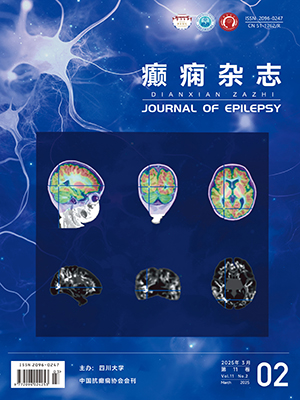Objective To study the clinical features of children with seizures as core symptoms of neuronal surface antibody syndromes.
Methods The clinical data of neuronal surface antibody syndromes between December 2015 and December 2016 were obtained and analyzed. All children presented to hospital with seizures as core symptoms.
Results There were 1 male and 9 females in this study. The ages ranged from 3 years to 13 years. The disease course was between 3 and 14 days. All children presented to hospital with seizures as core symptoms.Two children had tonic seizures. one had tonic-clonic seizure. Seven had partial seizures. Among them, six children had status epilepticus and cluster attack. The other symptoms in the course of the disease were psychiatric symptoms and extrapyramidal symptoms.The anti-NMDAR antibody were found in 9 patients' CSF and blood. The LGI1 antibody was found in one patients' CSF and blood.The EEG test of 7 patients showed slow wave and sharp slow wave. Two showed spike wave. One showed slow wave.The MRI test of one patient showed abnormal. Ten cases were treated with IVIG and methylprednisolone during acute stage. The patients had been followed up for 3 to 6 months. Eight of them recovered completely. Two cases had seizures. Two cases diagnosed with anti-NMDAR related epilepsy received sound effects after treated with cyclophosphamide.
Conclusions Convulsion may be the first common symptom of neuronal surface antibody syndromes in children. Immune factors should be screened when children with acute seizures and status epilepticus. Accompanying psychiatric symptoms, autoimmune epilepsy should be considered. The most common neuronal surface antibody in children with neuronal surface antibody syndromes is NMDAR antibody. EEG usually shows slow wave and sharp slow wave during seizures. Brain MRI is usually normal. Immunotherapy is effective in the majority of patients as the first line treatment. When the first-line treatment failed, second-line immunotherapy such as cyclophosphamide shock therapy on a regular basis is helpful.
Citation:
HU Chun-hui, SUN Dan, HU Jia-sheng, LIU Zhi-sheng. Clinical features analysis in 10 children with seizures as core symptoms of neuronal surface antibody syndromes. Journal of Epilepsy, 2017, 3(6): 479-483. doi: 10.7507/2096-0247.20170076
Copy
Copyright © the editorial department of Journal of Epilepsy of West China Medical Publisher. All rights reserved
| 1. |
Suleiman J, Brilot F, Lang B, et al. Autoimmune epilepsy in children: case series and proposed guidelines for identification.Epilepsia, 2013, 4(6): 1036-1045.
|
| 2. |
van Coevorden-Hameete MH, de Graaff E, Titulaer MJ, et al. Molecular and cellular mechanisms underlying anti-neuronal antibody mediated disorders of the central nervous system.Autoimmun Rev, 2014, 13(3): 299-312.
|
| 3. |
Höftberger R.Neuroimmunology: an expanding frontier in autoimmunity. Front Immunol, 2015, 6: 206.
|
| 4. |
Quek AM, Britton JW, McKeon A, et al. Autoimmune epilepsy: clinical characteristics and response to immunotherapy. Arch Neurol, 2012, 69(5): 582-593.
|
| 5. |
魏路华, 刘凤君, 高枫, 等.神经元表面抗体相关脑炎脑电图特点分析.中国现代神经疾病杂志, 2016, 16(9): 603-610.
|
| 6. |
Wang RJ, Chen BD, Qi D.Anti-N-methyl-D-aspartate receptor encephalitis concomitant with multifocal subcorticalwhite matter lesions on magnetic resonance imaging: a case report and review of the literature. BMC Neurol, 2015, 15: 107.
|
| 7. |
Dalmau J, Tüzün E, Wu HY, et al.Paraneoplastic anti-N-methyl-D-aspartate receptor encephalitis associated with ovarian teratoma. Ann Neurol, 2007, 61 (1): 25-36.
|
| 8. |
Leypoldt F, Armangue T, Dalmau J. Autoimmune encephalopathies. Ann N Y Acad Sci, 2014, 1338(1): 94-114.
|
| 9. |
Gaspard N. Autoimmune Epilepsy.Continuum (MinneapMinn), 2016, 22(1): 227-245.
|
| 10. |
Ehling P, Melzer N, Budde T, et al. CD8+ T cell-mediated neuronal dysfunction and degeneration in limbic encephalitis. Front Neurol, 2015, 6: 163.
|
- 1. Suleiman J, Brilot F, Lang B, et al. Autoimmune epilepsy in children: case series and proposed guidelines for identification.Epilepsia, 2013, 4(6): 1036-1045.
- 2. van Coevorden-Hameete MH, de Graaff E, Titulaer MJ, et al. Molecular and cellular mechanisms underlying anti-neuronal antibody mediated disorders of the central nervous system.Autoimmun Rev, 2014, 13(3): 299-312.
- 3. Höftberger R.Neuroimmunology: an expanding frontier in autoimmunity. Front Immunol, 2015, 6: 206.
- 4. Quek AM, Britton JW, McKeon A, et al. Autoimmune epilepsy: clinical characteristics and response to immunotherapy. Arch Neurol, 2012, 69(5): 582-593.
- 5. 魏路华, 刘凤君, 高枫, 等.神经元表面抗体相关脑炎脑电图特点分析.中国现代神经疾病杂志, 2016, 16(9): 603-610.
- 6. Wang RJ, Chen BD, Qi D.Anti-N-methyl-D-aspartate receptor encephalitis concomitant with multifocal subcorticalwhite matter lesions on magnetic resonance imaging: a case report and review of the literature. BMC Neurol, 2015, 15: 107.
- 7. Dalmau J, Tüzün E, Wu HY, et al.Paraneoplastic anti-N-methyl-D-aspartate receptor encephalitis associated with ovarian teratoma. Ann Neurol, 2007, 61 (1): 25-36.
- 8. Leypoldt F, Armangue T, Dalmau J. Autoimmune encephalopathies. Ann N Y Acad Sci, 2014, 1338(1): 94-114.
- 9. Gaspard N. Autoimmune Epilepsy.Continuum (MinneapMinn), 2016, 22(1): 227-245.
- 10. Ehling P, Melzer N, Budde T, et al. CD8+ T cell-mediated neuronal dysfunction and degeneration in limbic encephalitis. Front Neurol, 2015, 6: 163.




